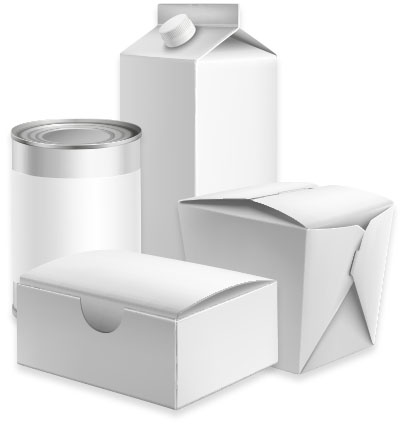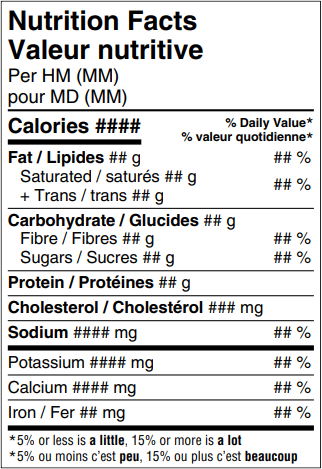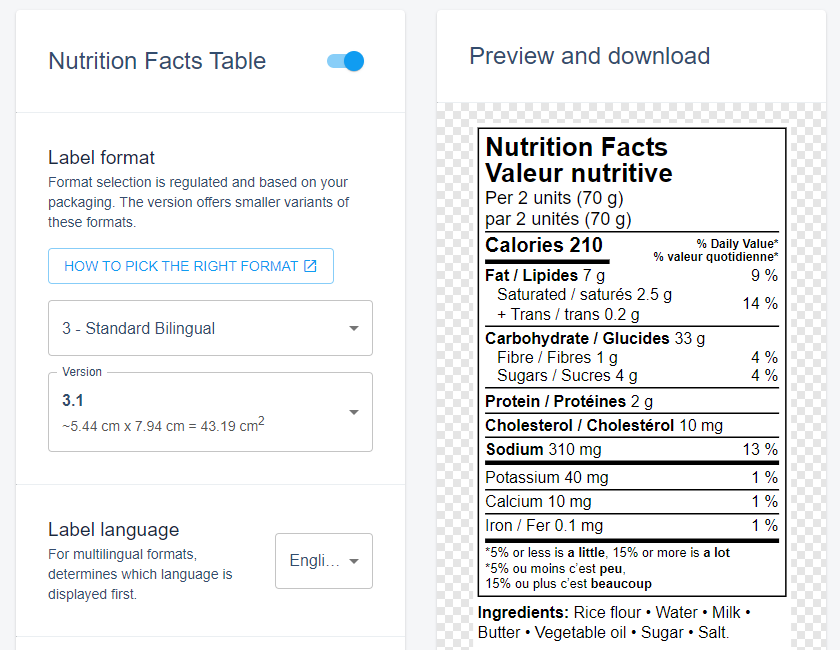In Canada, you must choose the NFt (Nutrition Facts table) format based on the dimensions of your packaging to ensure the best readability.
Here is a beginner’s guide on selecting an NFt format based on Canadian regulations. Please note that this guide is not meant to be extensive and doesn’t consider all possible formats. For all the details, please visit Health Canada’s website.
Step 1 – Measure your packaging
You need to calculate the Available Display Surface (ADS) of your food packaging. This means measuring the area of each face of your packaging.
Faces you can exclude when measuring:
- Bottom, if the product leaks or is damaged if upside down
- Area destroyed when opened (except for single-serve containers)
- Area where a label cannot be physically applied
- Area where information cannot be legibly set out or easily viewed

Step 2 – Choose a table format
Formats are identified by a number with a decimal that specifies their version. For example, the Standard Bilingual goes from 3.1 to 3.7. The higher the version, the smaller the table.
You must follow the regulated format priority and use the largest possible version that fits one continuous surface of your packaging. However, you can choose a smaller version if it takes more than 15% of your ADS.
All the steps are listed on the Government of Canada’s website, but here is a simplified list that should answer most types of packaging.
You must start with the Standard format, then move on to other options if it takes more than 15% of your ADS or does not fit one continuous surface:
1. Bilingual Standard (3)
| Format | Appr. size | Min. package ADS |
| 3.1 | 5.44 cm x 7.94 cm = 43.19 cm2 | 288 cm2 |
| 3.2 | 4.8 cm x 7.37 cm = 35.38 cm2 | 236 cm2 |
| 3.3 | 4.8 cm x 7.37 cm = 35.38 cm2 | 236 cm2 |
| 3.4 | 4.09 cm x 6.84 cm = 27.98 cm2 | 187 cm2 |

You may also look into the Narrow (2) or non-bilingual Standard (1) formats, more info here.
If your package ADS is smaller than the listed values, you can select the Horizontal (4) format.
2. Horizontal format (4)
| Format | Appr. size | Min. package ADS |
| 4.1 | 11.64 cm x 3.07 cm = 35.73 cm2 | 238 cm2 |
| 4.2 | 9.45 cm x 2.82 cm = 26.65 cm2 | 178 cm2 |

If your packaging’s ADS is still smaller than these minimum values, you may look into the smaller versions of the Bilingual Standard (3) and Horizontal (4) or choose to use a Linear (16) format.
3. Bilingual Standard (3), Horizontal (4), Linear (16)
| Format | Appr. size | Min. package ADS |
| 3.5 | 3.92 cm x 6.35 cm = 24.89 cm2 | 166 cm2 |
| 3.6 | 3.99 cm x 6.1 cm = 24.34 cm2 | 162 cm2 |
| 3.7 | 3.84 cm x 5.13 cm = 19.7 cm2 | 131 cm2 |
| 4.3 | 9.31 cm x 2.84 cm = 26.44 cm2 | 176 cm2 |
| 4.4 | 9.31 cm x 2.66 cm = 24.76 cm2 | 165 cm2 |
| 4.5 | 11.43 cm x 2.33 cm = 26.63 cm2 | 178 cm2 |
| 16.1 | 11.22 cm x 1.64 cm = 18.4 cm2 | 123 cm2 |
| 16.2 | 9.03 cm x 1.5 cm = 13.55 cm2 | 90 cm2 |

When can I use a simplified Nutrition Facts table format?
The simplified formats display fewer nutrients and are reserved for foods with zero value for six or more of the core nutrients. They also have a priority hierarchy which can be found here.
How do I display multiple foods on one nutritional label?
If your product contains multiple foods or needs to be prepared (ex.: a brownie mix), you might need to use a Dual or Aggregate format. Find out more here.
Do I need a bilingual Nutrition Facts table in Canada?
Throughout Canada, you need a bilingual format. However, there are a few exceptions:
- specialty foods
- local foods
- test market foods
If you need a bilingual label but the selected NFt format does not have a bilingual version, you must create a table for each language and display them both on your packaging.

